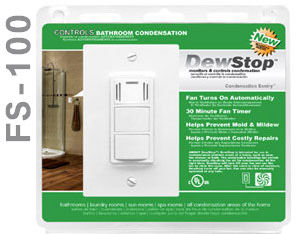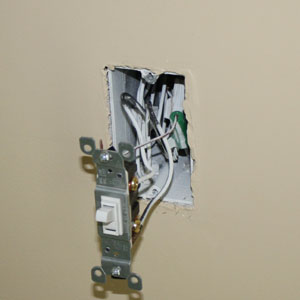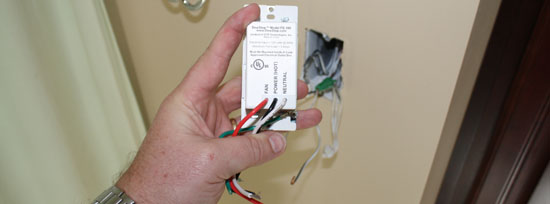DewStop Bathroom Fan Switch Review
DewStop™ – Condensation Sensing Fan Switch


Make Your Fan A Smart Fan
There are lots of great bathroom fan timers on the market but none of them take it a step further like the DewStop™ Fan Switch. DewStop™ Fan Switch uses technology to monitor temperature, humidity and dew point, similar to what meteorologists use for weather prediction. This sensory software finds the room’s condensation level and prompts the fan to turn on or off.
DewStop™ Features
- Fan turns off when condensation is no longer present on the walls
- Saves energy
- Low maintenance
- Long product life
- Use with your existing fan


- Manual on/off light control included with the FS-200 model
DewStop™ Fan Switch Review
We recently installed the DewStop FS-100 in one of our bathrooms to test and evaluate the product. For this particular application it was installed in a bathroom with a tub/shower combination, a dedicated bathroom exhaust fan and a separate light that’s wired with the exhaust fan.
DewStop™ Installation
The DewStop™ Fan Switch is very easy to install if you’ve got some basic electrical experience. Installing this switch is very similar to most switches with the exception that a neutral lead must be available.
This is true for all electronic type timers and 

Before you begin it’s very important that you shut off the electrical breaker that suppliers power to the room. Then go ahead and remove the old fan switch and exposing the ground, neutral and two hot leads.


DewStop™ Performance
As you can see in the photo above we tested the DewStop™ switch to see if it would automatically turn on as advertised. Well we’re happy to report that the switch turned on just as it’s supposed to when the bathroom filled up with moisture as you see above. Once the fan turned on it stayed on until the room was completely cleared out.
In addition to the automatic feature the DewStop™ can be turned on manually until you either manually turn it off or the 30 minute timer shuts it off. These features make the DewStop™ extremely versatile and much more advanced than simple timers.
Overall Impression
The DewStop™ Fan Switch works great. Having an automatic fan switch that senses humidity and dew levels is a huge advantage when trying to prevent mold and mildew in damp bathrooms. The fan switch is very easy to install and and control. Priced under $60 we think the DewStop™ is a great value and a product that home owners should consider for bathrooms, laundry rooms and even spa rooms.
Recent Posts
Framing Stick Nailer vs Coil Nailer
Which is Better a Stick Nailer or Coil Nailer? Framers have many choices in nailers…
How Many Roofing Nails Per Square of Shingles
Estimating How Many Nails for a New Roof When it comes to estimating materials for…
Composite / PVC Decking – Layout Tips & Advice
Composite / PVC Decking Layout Tips and Advice Composite and PVC decking have really changed…
Benefits of an ERV System (Energy Recovery Ventilator)
Benefits of ERV Systems (Energy Recovery Ventilator) If you're building a new home or doing…
Vermiculite Attic Insulation Abatement
Vermiculite Attic Insulation If your home was built before 1990 there is a chance it…
Nuisance Tripping of AFCI (Arc Fault) Circuit Breakers
Arc Fault (AFCI) Circuit Breakers Tripping Often An arc-fault circuit interrupter (AFCI) or arc-fault detection…
View Comments
Anyway to make this work without having a white neutral wire?
Thanks!
Not that I'm aware of!
Can I get a 3 way Dew stop switch? My bathroom has three way switches now and I want to replace the in the room switch and leave the regular 3 way on the outside of the room.
Barny
my original switch has 2 wires ,white and black oh and ground makes 3.
there is no red wire . where do i connect the red wire on the DEW STOP SWITCH to ??